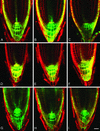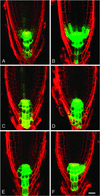Gravity-regulated differential auxin transport from columella to lateral root cap cells
- PMID: 12594336
- PMCID: PMC151453
- DOI: 10.1073/pnas.0437936100
Gravity-regulated differential auxin transport from columella to lateral root cap cells
Abstract
Gravity-induced root curvature has long been considered to be regulated by differential distribution of the plant hormone auxin. However, the cells establishing these gradients, and the transport mechanisms involved, remain to be identified. Here, we describe a GFP-based auxin biosensor to monitor auxin during Arabidopsis root gravitropism at cellular resolution. We identify elevated auxin levels at the root apex in columella cells, the site of gravity perception, and an asymmetric auxin flux from these cells to the lateral root cap (LRC) and toward the elongation zone after gravistimulation. We differentiate between an efflux-dependent lateral auxin transport from columella to LRC cells, and an efflux- and influx-dependent basipetal transport from the LRC to the elongation zone. We further demonstrate that endogenous gravitropic auxin gradients develop even in the presence of an exogenous source of auxin. Live-cell auxin imaging provides unprecedented insights into gravity-regulated auxin flux at cellular resolution, and strongly suggests that this flux is a prerequisite for root gravitropism.
Figures






References
Publication types
MeSH terms
Substances
LinkOut - more resources
Full Text Sources
Other Literature Sources
Miscellaneous

